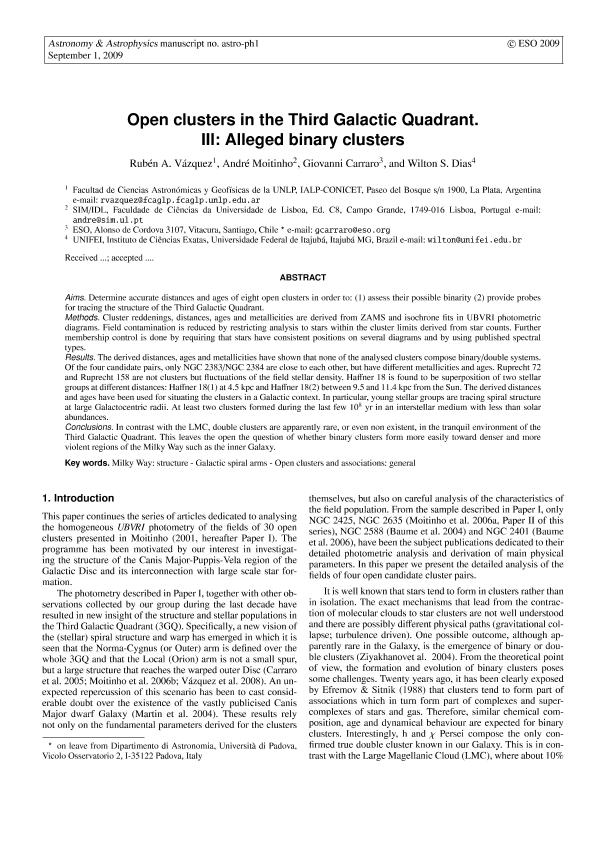Mostrar el registro sencillo del ítem
dc.contributor.author
Vazquez, Ruben Angel

dc.contributor.author
Moitinho, André
dc.contributor.author
Carraro, Giovanni
dc.contributor.author
Dias, Wilton S.
dc.date.available
2016-12-19T17:18:09Z
dc.date.issued
2010-03
dc.identifier.citation
Vazquez, Ruben Angel; Moitinho, André; Carraro, Giovanni; Dias, Wilton S.; Open clusters in the Third Galactic Quadrant. III: alleged binary clusters; EDP Sciences; Astronomy And Astrophysics; 511; 3-2010; 38-53
dc.identifier.issn
0004-6361
dc.identifier.uri
http://hdl.handle.net/11336/9725
dc.description.abstract
Aims. We aim to determine accurate distances and ages of eight open clusters in order to: (1) assess their possible binarity (2) provide probes to trace the structure of the Third Galactic Quadrant.
Methods. Cluster reddenings, distances, ages and metallicities are derived from ZAMS and isochrone fits in UBVRI photometric diagrams. Field contamination is reduced by restricting analysis to stars within the cluster limits derived from star counts. Further membership control is done by requiring that stars have consistent positions in several diagrams and by using published spectral types.
Results. The derived distances, ages and metallicities have shown that none of the analysed clusters compose binary/double systems. Of the four candidate pairs, only NGC 2383/NGC 2384 are close to each other, but have different metallicities and ages. Ruprecht 72 and Ruprecht 158 are not clusters but fluctuations of the field stellar density. Haffner 18 is found to be the superposition of two stellar groups at different distances: Haffner 18(1) at 4.5 kpc and Haffner 18(2) between 9.5 and 11.4 kpc from the Sun. The derived distances and ages have been used to situate the clusters in the Galactic context. In particular, young stellar groups trace spiral structure at large Galactocentric radii. At least two clusters formed during the last few 108 yr in an interstellar medium with less than solar abundances.
Conclusions. In contrast with the LMC, double clusters are apparently rare, or even non existent, in the undisturbed environment of the Third Galactic Quadrant. This leaves open the question of whether binary clusters form more easily toward denser and more violent regions of the Milky Way such as the inner Galaxy.
dc.format
application/pdf
dc.language.iso
eng
dc.publisher
EDP Sciences

dc.rights
info:eu-repo/semantics/openAccess
dc.rights.uri
https://creativecommons.org/licenses/by-nc-sa/2.5/ar/
dc.subject
Galaxy
dc.subject
Structure Of the Galaxy
dc.subject
Open Clusters
dc.subject.classification
Astronomía

dc.subject.classification
Ciencias Físicas

dc.subject.classification
CIENCIAS NATURALES Y EXACTAS

dc.title
Open clusters in the Third Galactic Quadrant. III: alleged binary clusters
dc.type
info:eu-repo/semantics/article
dc.type
info:ar-repo/semantics/artículo
dc.type
info:eu-repo/semantics/publishedVersion
dc.date.updated
2016-12-14T12:56:25Z
dc.journal.volume
511
dc.journal.pagination
38-53
dc.journal.pais
Francia

dc.journal.ciudad
Paris
dc.description.fil
Fil: Vazquez, Ruben Angel. Consejo Nacional de Investigaciones Científicas y Técnicas. Centro Científico Tecnológico La Plata. Instituto de Astrofísica de La Plata; Argentina
dc.description.fil
Fil: Moitinho, André. Universidade de Lisboa. Faculdade de Ciencias; Portugal
dc.description.fil
Fil: Carraro, Giovanni. European Southern Observatory; Chile
dc.description.fil
Fil: Dias, Wilton S.. Universidade Federal de Itajubá. UNIFEI Instituto de Ciencias Exatas; Brasil
dc.journal.title
Astronomy And Astrophysics

dc.relation.alternativeid
info:eu-repo/semantics/altIdentifier/url/http://www.aanda.org/articles/aa/abs/2010/03/aa11583-08/aa11583-08.html
dc.relation.alternativeid
info:eu-repo/semantics/altIdentifier/doi/http://dx.doi.org/10.1051/0004-6361/200811583
Archivos asociados
